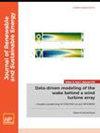Low-carbon economic operation strategy for multi-agent integrated energy system considering uncertainty of renewable energy power generation
IF 1.9
4区 工程技术
Q4 ENERGY & FUELS
引用次数: 0
Abstract
The uncertainty of renewable energy output threatens the operation safety of multi-agent integrated energy system (MAIES), which makes it difficult to balance the low-carbon economic operation demands of various stakeholders. However, the existing research solely focuses on the operational strategy of multi-agent game involving integrated energy suppliers and users in deterministic scenarios, overlooking the complementary supporting role and game interaction of shared energy storage and wind farm as independent entities of interest under the instability of renewable energy power generation. Hence, this paper first establishes the optimal operation models for integrated energy system operator (IESO), user aggregator (UA), shared energy storage operator (SESO), and wind farm operator (WFO) considering the stepped carbon trading. Second, in the face of the actual situation of uncertainty of photovoltaic and wind power output, fuzzy chance-constrained programming is adopted for processing. Then, a bi-layer game equilibrium model with IESO as a leader and UA, SESO, and WFO as followers is proposed, and the existence and uniqueness of Stackelberg equilibrium solution are proved. Finally, simulation calculation is carried out based on the YALMIP toolbox in the Matlab R2023a software, and the improved particle swarm optimization algorithm and CPLEX solver are used to solve the model. The results demonstrate that the participation of SESO and WFO as independent stakeholders in the game interaction can improve the economic and environmental benefits of MAIES. The iterative optimization of demand response subsidy prices can effectively motivate users to participate in demand response, improve the ability of MAIES to cope with the uncertain risks of renewable energy generation and load, and reduce the power grid dispatch pressure.考虑可再生能源发电不确定性的多代理综合能源系统低碳经济运行策略
可再生能源输出的不确定性威胁着多主体综合能源系统(MAIES)的运行安全,难以平衡各利益相关方的低碳经济运行需求。然而,现有研究仅关注确定性情景下综合能源供应方与用户多主体博弈的运行策略,忽视了共享储能与风电场作为独立利益主体在可再生能源发电不稳定性下的互补支撑作用与博弈互动。因此,本文首先建立了考虑阶梯碳交易的综合能源系统运营商(IESO)、用户聚合商(UA)、共享储能运营商(SESO)和风电场运营商(WFO)的最优运营模型。其次,面对光伏和风电输出功率不确定的实际情况,采用模糊机会约束编程进行处理。然后,提出了以 IESO 为领导者,UA、SESO 和 WFO 为追随者的双层博弈均衡模型,并证明了 Stackelberg 均衡解的存在性和唯一性。最后,基于 Matlab R2023a 软件中的 YALMIP 工具箱进行了仿真计算,并使用改进的粒子群优化算法和 CPLEX 求解器对模型进行了求解。结果表明,SESO 和 WFO 作为独立的利益相关者参与博弈互动,可以提高 MAIES 的经济和环境效益。需求响应补贴价格的迭代优化可以有效激励用户参与需求响应,提高 MAIES 应对可再生能源发电和负荷不确定性风险的能力,减轻电网调度压力。
本文章由计算机程序翻译,如有差异,请以英文原文为准。
求助全文
约1分钟内获得全文
求助全文
来源期刊

Journal of Renewable and Sustainable Energy
ENERGY & FUELS-ENERGY & FUELS
CiteScore
4.30
自引率
12.00%
发文量
122
审稿时长
4.2 months
期刊介绍:
The Journal of Renewable and Sustainable Energy (JRSE) is an interdisciplinary, peer-reviewed journal covering all areas of renewable and sustainable energy relevant to the physical science and engineering communities. The interdisciplinary approach of the publication ensures that the editors draw from researchers worldwide in a diverse range of fields.
Topics covered include:
Renewable energy economics and policy
Renewable energy resource assessment
Solar energy: photovoltaics, solar thermal energy, solar energy for fuels
Wind energy: wind farms, rotors and blades, on- and offshore wind conditions, aerodynamics, fluid dynamics
Bioenergy: biofuels, biomass conversion, artificial photosynthesis
Distributed energy generation: rooftop PV, distributed fuel cells, distributed wind, micro-hydrogen power generation
Power distribution & systems modeling: power electronics and controls, smart grid
Energy efficient buildings: smart windows, PV, wind, power management
Energy conversion: flexoelectric, piezoelectric, thermoelectric, other technologies
Energy storage: batteries, supercapacitors, hydrogen storage, other fuels
Fuel cells: proton exchange membrane cells, solid oxide cells, hybrid fuel cells, other
Marine and hydroelectric energy: dams, tides, waves, other
Transportation: alternative vehicle technologies, plug-in technologies, other
Geothermal energy
 求助内容:
求助内容: 应助结果提醒方式:
应助结果提醒方式:


